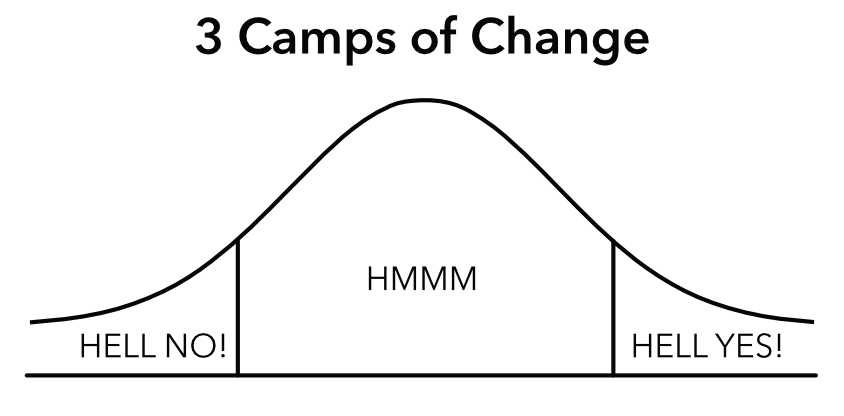Leadership 401: Turning to jerks for wisdom
The squeaky wheel may get the grease, but the skilled driver reaches their destination.
Whether you’re trying to upgrade your business results or you’re a new President of the United States (leaning left or right), you need to understand a secret of why many fail and a few succeed to lead change.
The insight is simple once you see it.
It sounds like a really bad idea until you understand it: the jerk who’s fighting you can become your friend in foe’s clothing.
Creating breakthrough change is messy….and predictable.
If you’re wanting to lead people to the future nirvana that you envision, some things are predictable. This insight works if you are wanting to lead as few as five people. If there are 500 or 5 million people, it’s even more predictable.
Before you (or any past-present-future President) are even done sharing your vision of the future, people will place themselves in three main camps (see bell curve below). Your idea has only minimal influence on which camp they choose. What matters is:
A. what their perspective was before you started talking, which dictates more about what they will “hear” than what you actually say, and
B. how near or far what they “heard” you say is from how they experience their current state.

The graphic above shows how people will react to your vision. You can use it as reference for the next time you intend to lead your own revolution.
The 3 Camps of Change
- Camp “Hell YES!” The people in this group will jump up and down in agreement with your ideas. Two main things are at play for them. Most importantly, they feel relief that you’re pointing out the pain points they’d been experiencing. They can imagine these pains being swept away as your bold ideas come to life, even if you haven’t yet told them how you’ll do it. Relief from pain is a powerful motivator, and they’re on board. Many of those people also resonate with the picture of the future you’re painting, but it’s your acknowledgment of their discomfort that captured their loyalty. From this group will emerge the huge advocates, the flag-wavers. In politics, they call this “your base,” but it comes to life in any situation of change, business, social, religious, scientific. (This group isn’t necessarily as awesome as it seems, btw, because at least some of what they “heard” you say isn’t what you actually said. You’ll need to suss that out later.)
- Camp “Hell NO!” In some ways, this is just the negative image of the “YES!” camp. When you describe your vision of the future and the problems it will solve, those problems don’t jive with their experience. In fact, they may disagree with you mightily. But most important, it’s your solutions that are so unappealing. In fact, what they heard about your solutions evoked a level of discomfort ranging from frustration to full-on anger and fear. Their biggest concern is that you’re going to wreck some really important things they hold as precious and “truth.” They feel that YOU (not just your ideas) are unsafe. It’s those perceived threats that will quickly generate strong emotions and actions against you. When they react, it’ll feel to you like they’re jerks about it. But from their perspective, they are protectors. For example, when one executive declared “we will create an exceptional experience for our customers,” an idea that can’t be any more apple pie-like, one person from this camp immediately tracked them down and told them, “your plans will give away the store and put us out of business, and it is my mission to stop you.”
- Camp “Hmmm” These people represent the great majority of your audience. They aren’t yet for or against your vision, neither enthusiastic nor resistant. Some of them are confused by what you said. Either your message isn’t true to their experience or your logic just doesn’t add up in their way of thinking. Some just aren’t interested. Some of them need more information. Some want to know what their friends think. But the result is a large group of people who aren’t moving toward or away. This camp spreads out along a continuum between HELL YES! and HELL NO!
You’ll invoke different influencing strategies with each group.
Much of this is obvious, right? Mobilize the HELL YES’er’s. For the Hmmm’s, develop ways to better understand their questions and concerns, connect with the influencers they’re listening to, and provide more helpful information to Hmmm’s most relevant questions.
Invalidate the jerks!!!!
But pretty much universally, you and I and every PTA member or President that’s failed to create sweeping change make the same mistake. We want to ignore the HELL NO! camp. They can seem like such incredible jerks. Why fuel them with any of your energy? Why waste your precious attention and time on them?
Separate the person from their message and methods.
There will always be some HELL NO! folks who would just rather destroy you than understand you. Even if they don’t have a clue what you’re talking about, they’re unwilling to budge one millimeter toward you.
AND, within that HELL NO! camp are others who can potentially become some of your great future advocates if you can stop reacting to their unpleasant, fear-based behavior and try to understand what they’re actually saying. At the very least, they are loaded with knowledge and insight that you absolutely need. To listen to them will require remarkable Resilience to not get triggered by them, but it’s worth it.
Things that make you say Hmmm.
If you’re really committed to bring your vision to life and have it last for at least 60 seconds beyond the moment you turn your attention elsewhere, you’ve got to stop saying HELL NO! to their HELL NO! response. Some of these people you experience as jerks are actually wisdom bearers. With them, you’ve got to take a Hmmm mindset.
Remember that what often causes most people to say HELL NO! to your ideas are the solutions you’re offering to problems they don’t think exist. Your solutions threaten something valuable to them. And some of them are correct.
Renowned philosopher, Ken Wilber, said it best: “I’ve never met someone who’s 100% wrong.” (paraphrased) These folks may be on the ground of this situation, much closer to it than you are. They may have lived with it for years. They may understand better than you do that, if you do what you say you’re going to do, you’re going to create some really bad unintended consequences that you don’t want, either. (That’s what the HELL NO! guy meant when he said he was going to stop my client from giving away the store.)
Some of these people are being difficult because they have knowledge that you are completely blind to. And in many cases, they can help generate some alternatives that will allow you both to win. You’ll achieve your vision. They’ll get to protect what is precious to them, which could even prove precious to you once you also see what they see.
Do you really want to lead a positive revolution?
The HELL YES! crowd will bring you energy. You need them.
But finding the wisdom bearers within the HELL NO! group and integrating their ideas into your approach will do at least two helpful things. First, these HELL NO! people may actually become some of your greatest advocates.
But more importantly, often the most influential people for engaging the Hmmm camp are the people who once opposed you who’ve changed their view after deep consideration.
Of course you and your HELL YES’ers like your idea. But the undecided often place the greatest credibility in someone who had no good reason to join your efforts but who did it anyway, not for you but for themselves. And there may be a correlation between the magnitude of their jerk-factor beforehand and their ability to sway people after they become your ally.
If you really want to change the world for the better, give your own HELL NO! a rest, take a breath of patience, and greet them with a sincere Hmmm.
Want to bring your brilliant ideas to life with greater success?
For 25 years, I’ve helped leaders with a vision for a better future bring those ideas to life, helping them apply insights like turning to “jerks” for their wisdom.
The foundational skill of these all leaders of important change is Resilience, the ability to keep leading well when things are not going well. Whether it’s taming the jerks or managing your own lack of confidence and clarity when things are falling apart, remarkable Resilience is a must-have skill. You must build it now for when things get messy. Learn what crushes your Resilience and how to proactively build it in the Mind to Win program, a five-week sprint that begins on February 1.


Comments are closed.